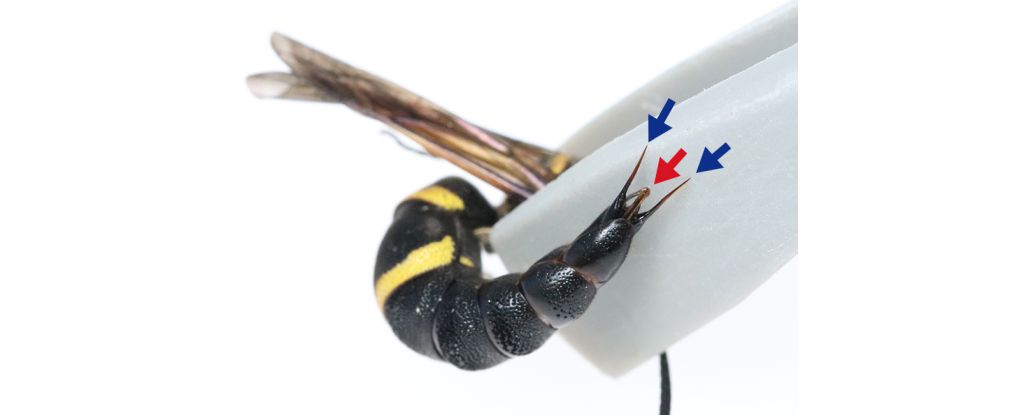A species of wasp living in Japan appears to have developed a rather unconventional method of repelling attacks.
Researchers observed the male of the mason wasp species Anterhynchium gibbifrons Using spikes flanking the penis as a weapon – with varying degrees of effectiveness – against hungry frogs who think the insect might make a tasty snack.
“This study,” write ecologists Shinji Sugiura and Misaki Tsujii from Kobe University in Japan, “highlights the importance of male genitalia as a defense against predators and provides a new perspective for understanding the ecological role of male genitalia in animals.”
Some insects of the order Hymenoptera – wasps and bees – can deliver venomous stings as a mechanism of attack or defense against prey and predators. However, only females of these species have a venomous sting; If you are stung by a female wasp, she will sting you with her ovipositor, which can either emit venom or eggs, depending on the situation.
Male wasps are thought to be harmless, and in some cases this is true: they actually lack the apparatus to deliver a painful sting. But while studying A. Gibbifrans – a species Discovered in 2015 – Sugiura and Tsuji noticed something strange. When handling a male of the species, it delivered a rather painful sting to Tsuji using spikes that protruded near the insect’s penis.
Such stingers are seen on some species of wasps and are known as “pseudo stingers”. Intrigued after being on the receiving end of it, the researchers decided to study its function in detail.
For some insects, hooks and barbs can help deter the female from wriggling away during mating. In a lab setting, however, the pseudo-stinger is of A. Gibbifrans played no part in amorous proceedings.
The next step was to examine whether the wasps often used the equipment defensively. pond frogs of the species Pelophylax nigromaculatus and tree frogs of the species Dryophytes japonica were recruited, and Sugiura and Tsuji set about observing how the amphibians and insects interacted under different conditions.
frameborder=”0″ allow=”accelerometer; autoplay; write clipboard; encrypted media; gyroscope; picture-in-picture” allow full screen>
Seventeen tree frogs each received a male wasp. All the tree frogs opened their mouths to eat the wasps, which defended themselves with their mandibles and pseudo-stings. In the end, 35.3 percent of the frogs gave up and the wasp escaped.
As a control, 17 different tree frogs were provided with a male wasp whose genitalia had been removed. All 17 of these wasps were practically devoured.
Female wasps were made available to 17 other tree frogs. Only 47.1 percent of these frogs attempted to eat the female wasps, and most of them gave up after the attack.
The pond frogs, on the other hand, simply didn’t care. They ate all wasps in all conditions. It seems that pond frogs laugh at stings and pseudo-stings alike.
However, the success of male wasps in ridding themselves of tree frogs a significant percentage of the time suggests that their pseudostings are in fact an important defense for some male wasp species.
“Although male wasps are thought to mimic the morphology and behavior of stinging female wasps, we have shown that the genital spines of males A. Gibbifrans can counter predators”, write the researchers.
“The defensive role of male genitals as counterattack tools is found in many wasp species, males of which have pseudo-stings in their genitals.”
The research was published in Current Biology.





